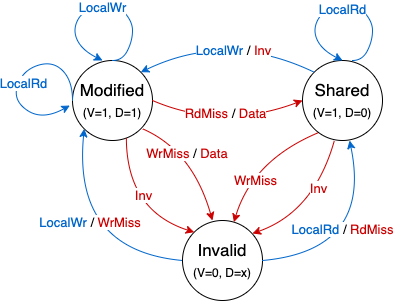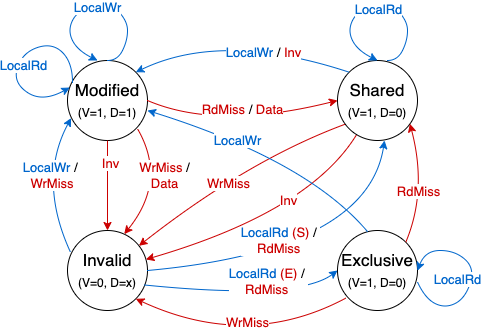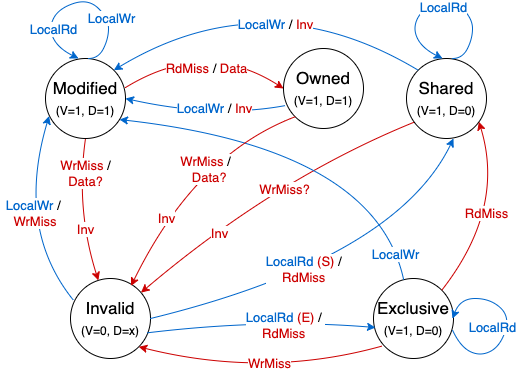Trace-driven simulation for cache coherence protocols.
Blue arrows are transitions driven by local (CPU) input, while red arrows are transitions driven by messages snooped from the bus. Bus message-triggered transitions not shown do not change state.
- MSI [implemented]: Simple coherence protocol for write-back caches, with modified, shared, and invalid states. A dirty cache block is also written back to memory whenever the data is put on the bus due to another cache requesting it.

- MESI [implemented]: MSI with an addition of "Exclusive" state, when an invalid line receives a local read, and no other cache contains the line. The advantage of this is fewer bus transactions/invalidations since the exclusive block can be modified without invalidating the block in other caches. Based on the Illinois protocol.

- MOESI [in progress]: MESI with an addition of "Owned" state. A cache line in the owned state is shared and dirty. The advantage is that modified data doesn't have to be rewritten to memory every time it is requested from another processor; the processor with the "Owned" line can directly share the data with the requester. See a similar MOESI protocol used in AMD64 Architecture.

- Dragon and Firefly?
State transition logic is abstracted in Cache::transition_bus and Cache::transition_processor
- Each cache block has corresponding entry in directory. Entry is num_cores + 1 bits wide, with one bit corresponding to whether the block is valid in each core, and one bit for whether the block is exclusive to that core.
- LRU replacement policy used.
- Currently supports byte-sized read and writes. Default value (if not written to before) is 0.
- TODO:
- Fix writeback and AMAT stats for cache. Calculate AMAT for overall system based on config stats.
- Deal with bus widths smaller than line size (for calculating access times)
- Generate memory traces with Intel's Pin tool
- Potentially model caches/memory as threads running concurrently. Will need arbiter or some kind of control for synchronizing bus usage.
To compile/link, run make.
To run, using a single trace file for all cores:
$ ./simulator <config> -s <trace file>
Example:
$ ./simulator config.txt -s traces/simple.trace
If using a separate trace file for each core (order of accesses is unpredictable):
$ ./simulator <config> -p <space delimited list of trace files>
Use the -v flag for verbose output (see when there is a data request from memory, writeback to memory, invalidation, and state changes for cache blocks) and/or -t for testing mode.
The simulation outputs a line for each memory access and uses values provided in the config file to compute stats like miss rate, AMAT, writebacks, and invalidations. See outputs/ for sample outputs.
<number of cores>, <coherence protocol>
<line size>, <cache size>, <associativity>, <hit time>, <miss penalty>
<shared memory size>, <data bus width>
All sizes are in bytes. Hit time and miss penalty are assumed to be in terms of number of cycles.
- MSI = 0
- MESI = 1
- MOESI = 2
Each line should be of the following form:
<core num> <access type> <address> <data>
- data read = 0
- data write = 1
- instr fetch = 2
- Expected value for a read
- Required for testing mode, may omit for non-testing mode
- Value to be stored for a write